|
|
|
Sort Order |
|
|
|
Items / Page
|
|
|
|
|
|
|
| Srl | Item |
| 1 |
ID:
140958
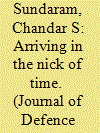

|
|
|
|
|
| Summary/Abstract |
Today, military historians as well as those dealing with colonial South Asian history tend to overlook the fact that during the First World War, the Indian Army was Britain’s strategic reserve. It vitally despatched over 150,000 troops to the Western Front to shore-up the British sector in the critical period of 1914-1915. To the Indian sepoys who crossed the kala pani to fight, die or be wounded in the trenches there, it was a jarring initiation into modern industrialised warfare. This article examines that episode and advances two arguments: first, that, contrary to accounts written as recently as the 1980s, Indian sepoys performed quite well in the trenches; second, that racial concerns and the advent of the Kitchener armies, rather than a poor combat record, led to their transfer from the Western Front at the end of 1915.
|
|
|
|
|
|
|
|
|
|
|
|
|
|
|
|
| 2 |
ID:
140956
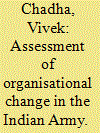

|
|
|
|
|
| Summary/Abstract |
The article analyses military change in the context of the Indian Army, with specific focus on organisational innovation and change. In doing so, it analyses two case studies: restructuring of the army after the Sino-Indian War of 1962; and mechanisation based on the 1975 expert committee recommendations. On the basis of these case studies, the article assesses the drivers and desirables for organisational change in the Indian Army, with the further aim of deriving policy recommendations which are especially apt in light of the ongoing transformation of the army. It identifies operational environment and technology as the principle drivers for change, with doctrine and strategic culture having a limited impact. It further concludes that successful change requires long-term strategic assessment, supportive political leadership, visionary and committed military leadership, strong institutional structures and follow-up action.
|
|
|
|
|
|
|
|
|
|
|
|
|
|
|
|
| 3 |
ID:
140959
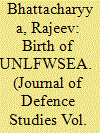

|
|
|
|
|
| Summary/Abstract |
A distinctive feature of insurgency in India’s North-East and neighbouring Myanmar has been the tendency among rebel groups to form alliances. Cooperation is deemed advantageous in a hostile terrain, against a powerful and better organised enemy. Several coalitions were formed in Myanmar by the separatist insurgent outfits with well-defined objectives which, however, failed to produce any significant impact on the campaign for independence of the region. There were centrifugal forces pulling in different directions, often determined by the resources available with the groups, their long- and short-term goals, and the domestic situation in the areas they hailed from. The new alliance called United National Liberation Front of Western South East Asia (UNLWSEA) has emerged in the backdrop of vastly changed situations in Myanmar and India’s North-East. So it is different from the previous endeavours in much the same way as it suffers from the lacunae that hampered complete unity in the past.
|
|
|
|
|
|
|
|
|
|
|
|
|
|
|
|
| 4 |
ID:
140960
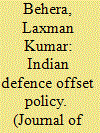

|
|
|
|
|
| Summary/Abstract |
The article assesses the impact of defence offset policy on the Indian defence industry, by taking into account two key parameters—foreign direct investment (FDI) inflows and exports. It observes that the offset policy has a mixed impact. On the positive side, the offset policy seems to have an impact on certain types of exports. On the negative side, the policy has not been a catalyst in bringing in foreign investment and technology inflows into the Indian defence industry, nor has it been successful in promoting its high-end manufacturing. Besides, majority of exports that the policy seems to have promoted is largely confined to parts and components.
|
|
|
|
|
|
|
|
|
|
|
|
|
|
|
|
| 5 |
ID:
140955
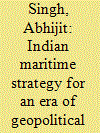

|
|
|
|
|
| Summary/Abstract |
The fractious nature of maritime relations in the Asia-Pacific region is a recognisable feature of international geopolitics today. Following China’s massive reclamation and ‘island-building’ project in the South China Sea recently, many Pacific states have moved to bolster their maritime postures. While Japan has sought legislative amendments to liberate its maritime posture from post-war passivism, Vietnam and the Philippines have been building stronger navies aimed at countering China’s hostile moves in the South China Sea. Meanwhile, Indonesia has sought to renew its capabilities as a maritime power through a new ‘maritime axis’ strategy, while Australia has boldly advocated an ‘Indo-Pacific’ framework for joint security endeavours and the creation of ‘middle-power coalitions’. In the interim, Russia has updated its maritime doctrine, announcing its military partnership with China as the cornerstone of its naval strategy in the Pacific.
|
|
|
|
|
|
|
|
|
|
|
|
|
|
|
|
| 6 |
ID:
140957


|
|
|
|
|
| Summary/Abstract |
India’s Professional Military Education (PME) system is weighted towards the tactical level in all stages of professional development. This results in inadequate exposure of its senior leadership to strategic studies, thus inhibiting the provision of qualitative advice at the strategic level. While combat as an instrument of warfare is focused on at all levels, it fails to relate to war as an instrument of politics. It underlines the absence of an effort to build a broader vision that incorporates the entire constellation of forces. As a general rule, technology has been privileged over humanities in PME. Although the establishment of the Indian National Defence University (INDU) will address some of the shortcomings, a concurrent review of syllabi in the premier joint training institutions is essential in order to achieve a balanced, progressive shift from an emphasis on technology at the initial stages to a humanities focus at the senior levels.
|
|
|
|
|
|
|
|
|
|
|
|
|
|
|
|
|
|
|
|
|